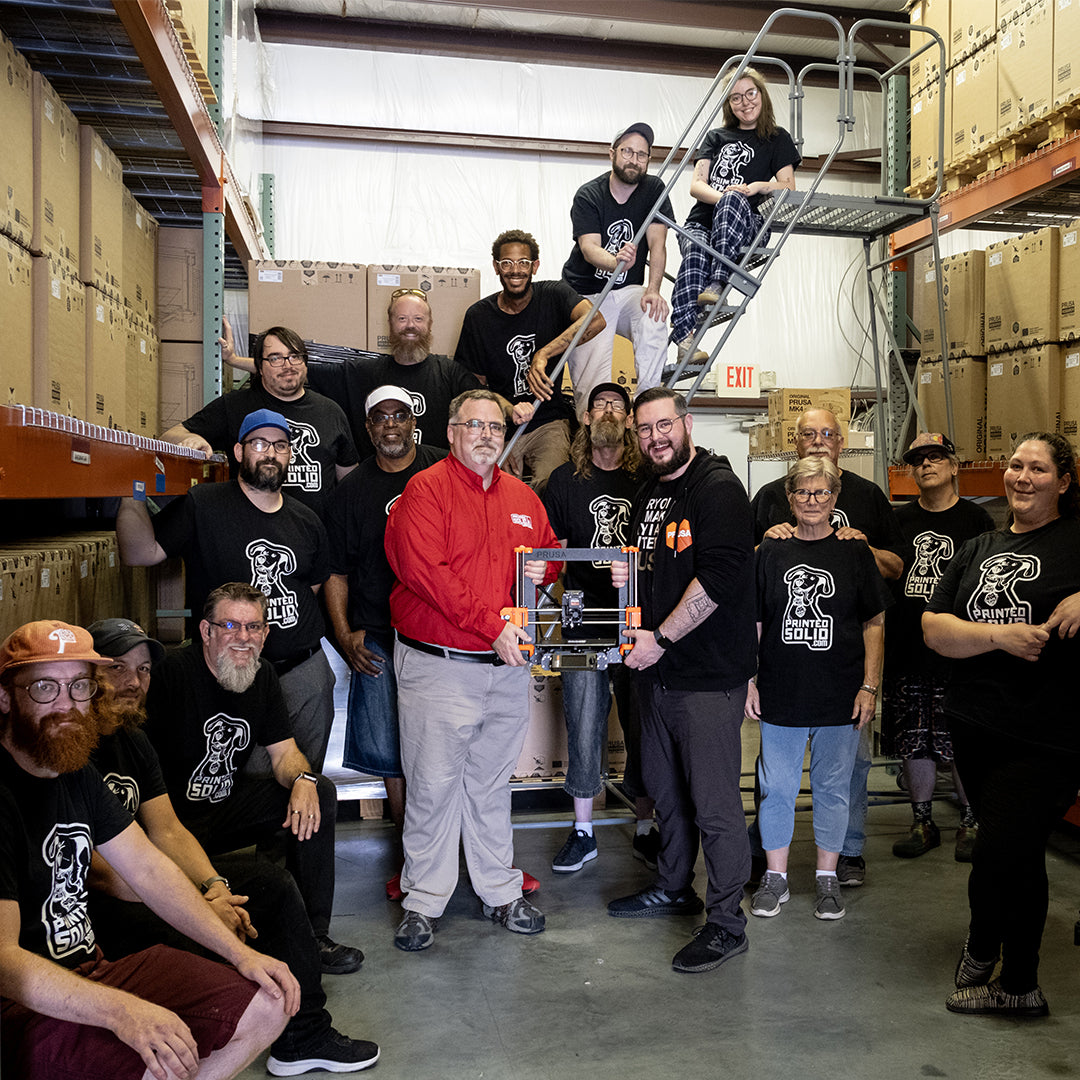
Why you won’t find a HEPA filter hanging on the back of our enclosures.

First we should talk about 3D printer enclosure designs and why you may want one. Enclosures serve three main purposes. 1) It helps keep heat in and prevent drafts over your build volume. 2) It keeps pets and hands away from hot ends and beds and pinch points. 3) It can help control VOC’s (volatile organic compounds)
- Keeping the heat in is what most people think of when they think of enclosing a 3D printer. This can be a factor to some degree but too much heat is also a problem for a lot of materials and printers. There are lots of designs for 3D printers which try to completely seal in a printer and insulate it and people try to add heating elements to make it even hotter inside. If you look at your printer it most likely have some or even a lot of plastic parts to it. Even if you have an all metal printer you might still have plastic fans, wire components, belts and so forth. Plastic gets weaker as it gets warmer, long before it gets to the melting point. So if your printer has any mechanical or structural components in it made of plastic then they can wear out or fail if it gets too warm inside a completely sealed enclosure. So heat is a friend and an enemy at the same time. Another problem with too much heat is that most extruders have a passive fan cooling the heat sync part. So if that gets too warm then you face heat creep and your extruder jams. So our enclosures have intentional openings on them to allow excess heat to escape while still preventing drafts over the build plate. It’s a delicate balance of retaining heat and releasing heat. A great example is a competitor out there completely seals up a Ultimaker printer top completely. Then as a user prints higher temp materials for a long time the plastic clips on the gantry soften and then entire XY axis drops out of the printer. Causing damage that if you weren’t watching it would be extremely expensive to repair. We have seen Prusa printers completely melt inside a hot box and even Raise3D recommends removing their hood while printing PLA so you don’t get heat creep on your extruder and it jams. So a little heat is ok but a lot is bad.
- Keeping pets and little fingers out of the printer. It’s a minor concern but one to think about none the less. Your cat will like the warmth of the heated bed and may even think it’s a moving toy to swipe at. With the hot parts and moving parts it could hurt your curious pets if they go snooping around. The same is true for kids. However with kids it has an additional factor. At home or in school people will bring kids right up to the machine so they can see the magic of 3D printing. As close range a tiny hand sticks out at touches the hot end and now you have a crying child to deal with.
- Volatile Organic Compounds. Even the words sound scary. There have been lots and lots of studies about it so we don’t have to go into the fine science of the issue. One thing that is not mentioned and is commonly misunderstood is VOC’s and HEPA. So lets get some simple numbers out there. HEPA ratings matter but you would be surprised by how much they don’t matter. Confused? That is the way they want it. Basically a 99.97% HEPA filter will capture a .3 micrometer particle, also called a H14 class filter. At the low end you have a 85% HEPA filter which is 85% or E10 rating. At the extreme high end you get into ULPA filters up to 99.9999% or U17 rating. OK, I said I would keep it simple and I haven’t, so I’m sorry for that. Let me try again and simplify these numbers even more for you. Most HEPA filter options are from 85% to 99.97% and capture particles down to .3 micrometers. The closer to 99.97% you get then the fewer amount of those particles get through the filter. You will rarely find a higher filter rating above 99.97% that won’t cost less than a car and require almost monthly replacement but those filters get you down to .1 micrometer particle sizes.
A quick summary: Most HEPA filters capture around .3 micrometer particle sizes and the better quality ones let fewer .3 micrometer particles get through.
Now to quickly shorten up all of those research papers for you about VOC’s and 3D printing.
- The particle size of the emissions from a 3D printer are between .1 and .3 micrometers.
- The amount varies depending on what material you print with.
- Most HEPA only filters will only capture the largest of these particles.
- An open window or well ventilated room will drop the levels below safety standards.
What about those particles smaller than .3 micrometers?
Well you can get one of those filters that cost as much as a car every month or you can used activated carbon. Activated carbon comes in many flavors and some of the facts can be misleading but to simplify it I will keep the scope limited. Basically the size of the activated carbon matters, smaller the size of the carbon the better. Then the amount of activated carbon matters. More is better. Activated carbon works using adsorption. No that is not a misspelling, I said adsorption which is different than absorption. Basically activated Carbon holds those VOC’s to its surface. So the size of the activated carbon matters because the smaller it is then the more surface area it has and the more VOC’s it can trap. Then there is the amount. Small amounts trap less than large amounts. The worse activated carbon filters out there are the woven mat filters like you find on a fish tank filter. They weigh nothing and are usually a plastic or cloth mesh covered in a thin coat of activated carbon and you can see light pass right through it. So even if they captured every particle passing through them then it would fully adsorption all of the VOC’s in a week or two.
Finally! Why we don’t put a small HEPA filter hanging off the back of our enclosures.
Those tiny fans with “HEPA” filters hanging off the back of some enclosures or printers do almost nothing and even less after a week of being on. It’s great marketing for sure and that is it. They barely move enough air to pull VOC’s through the filter. A total build volume of a printer is around 2 cubic feet. The recommended exchange rate at that size would 30 CFM after the filter. So those tiny filters that say 30 CFM fans are saying the fan moves 30 CFM but after the filter that number can drop to under 5 CFM. So not only do those small filter not capture enough particles, wear out in a week or two but they don’t even move enough air to actually move the particles through the filter to be captured.
Another issue is that a one way filter like those negate the entire purpose for an enclosure. The filaments with the highest particle emission’s like ABS, Polycarb, Nylon are the ones that need a warm enclosure. So if you are filtering air out of your printer then where is the new air coming from to fill the void? You’re not creating a vacuum so air is coming into the printer from somewhere. Cold air from outside the printer is being drawn into the printer and creating cold drafts across the print area and creating warping and de-lamination of your prints. Or worse those small filters are pulling cold air from gaps near the filter and not your print area and not capturing any particles, making you believe you are being safe and actually not filtering anything.
This is why we teamed up with BOFA and their line of filters. With the Print Pro 3 you get a true 88 CFM after the filter rating and a 3 stage filter with a pre-filter to capture 5 micrometer particles, then a true 99.997% HEPA filter and over 4 lbs of activated carbon to capture the .3 micrometer particles and VOC’s instead of just an ounce or two on the other solutions. On top of that it also has a supply and return hose to get the heated air back into the chamber without creating cold drafts over your print area. Then to top it off it has a warning indicator to tell you when to replace the filter. We searched high and low and found the BOFA units to be the only solution out there in this price range. While the science is still out on how the VOC’s might affect users over long time exposure, we don’t want to offer a solution that is just a placebo. We wanted a solution that actually addressed the issue. Since most consumer’s don’t have a way to test for VOC’s and UFP’s to find out if a filter is actually working we want to make sure the ones we sell actually do it.
